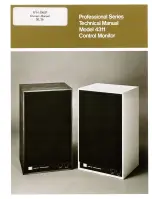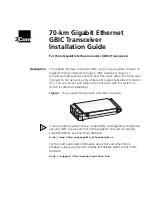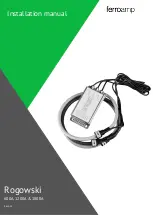
S1400T-2808B
Page 4-2
Section 4 - Lightning & Surge
Thunderstorms are cloud formations that produce lightning strikes (or strokes). Across the
United States there is an average of 30 thunderstorm days per year. Any given storm may
produce from one to several strokes. Data on the subject indicates that for an average area
within the United States there can be eight to eleven strokes to each square mile per year.
The risk of stroke activity is increased for various areas such central Florida where up to 38
strokes to each square mile per year are likely to occur.
To determine the probability of a given structure (tower, building, etc.) (within your
location) being struck, perform the following computation:
1.
Using the map of Figure 4-1 (or a comparable meteorological map for your local), find
the Isokeraunic level (I) for your area. Then using Chart 1, find “A” for your area.
2.
Refer to Figure 4-1 to find the latitude. Then using Chart 2, find “B” for your latitude
(Lat.°).
3.
Multiply “A” x “B” to get “C”.
4.
To calculate the number of lightning strikes per year that are likely to strike a given
object (tower, mast, etc.), use the equation that follows (where “C” was calculated in
step 3 and “H” is equal to the height of the object.
Strikes Per Year = (“C” x H
2
) ÷ (.57 x 10
6
)
Chart
1
Chart
2
I
“A” LAT.°
“B”
5
8 25
.170
10
26 30
.200
20
85 35
.236
30
169 40
.280
40
275 45
.325
50
402
60
548
70
712
Note for these charts:
80
893
I = Thunderstorm Days Per Year (Isokeraunic Number)
90
1069
A = Stroke activity for associated Isokeraunic Area
100
1306 B = Height/Stroke coefficient for associated latitude
For Example:
On Long Island, New York (Isokeraunic number 20), Chart 1 gives “A” to
equal 85. The latitude is approximately 40°. Referring to Chart 2, “B” is found to be equal to
.28. “C” for this example is equal to 23.80. Using the equation for strikes per year, it is
determined that a 100-foot tower has .4 chances per year of being struck by lightning.
Assuming that no other structures are nearby, the tower will more than likely be struck by
lightning at least once in three years.
Note: The Isokeraunic activity numbers connoted as I, “A” and “B” in Charts 1 and 2 above
are provided for the continental United States. Isokeraunic data for various countries
is available from various federal or state Civil Engineering or Meterorelogical
organizations. This information is typically available from manufacturers of lightning
strike protection equipment (such as Lightning Arresters).
Since Series 2808 Transmitters are powered from DC supplies that are isolated from AC
grids (as they don’t draw power from them), they are typically immune from lightning
strikes to power lines or power equipment (except for inductive flashover due to close
installation proximity).
Summary of Contents for Bristol 2808 Series
Page 12: ...BLANK PAGE ...
Page 14: ...1 2 Introduction 2808B Figure 1 1 2808 XXB Transmitters ...
Page 16: ...BLANK PAGE ...
Page 30: ...BLANK PAGE ...
Page 32: ...1B 2 DP Transmitters 2808B Figure 1B 1 Model 2808 35B Figure 1B 2 Transmitter Assemblies ...
Page 40: ...1B 10 DP Transmitters 2808B Figure 1B 6 Transmitter Housing Rotation Diagram ...
Page 54: ...BLANK PAGE ...
Page 57: ...2808B Calibration 3 3 Figure 3 2 Calibration Adjustments ...
Page 60: ...3 6 Calibration 2808B TABLE 3 A COARSE ZERO SWITCH SETTINGS Elevation ...
Page 61: ...2808B Calibration 3 7 TABLE 3 B COARSE ZERO SWITCH SETTINGS Suppression ...
Page 66: ...BLANK PAGE ...
Page 68: ...4 2 Service 2808B Figure 4 1 Using Internal TEST Terminals to Measure Current ...
Page 72: ...BLANK PAGE ...
Page 74: ...BLANK PAGE ...
Page 90: ...BLANK PAGE ...
Page 92: ...BLANK PAGE ...
Page 100: ...BLANK PAGE ...
Page 128: ...BLANK PAGE ...
Page 139: ...BLANK PAGE ...
















































